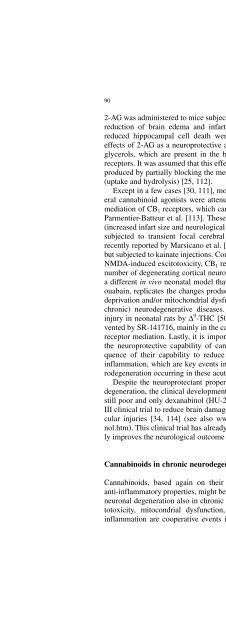3. Umbruch 4.4..2005 - Online Pot
3. Umbruch 4.4..2005 - Online Pot
3. Umbruch 4.4..2005 - Online Pot
You also want an ePaper? Increase the reach of your titles
YUMPU automatically turns print PDFs into web optimized ePapers that Google loves.
90 J. Fernández-Ruiz et al.<br />
2-AG was administered to mice subjected to closed head injury and significant<br />
reduction of brain edema and infart volume, better clinical recovery and<br />
reduced hippocampal cell death were documented [15]. Interestingly, the<br />
effects of 2-AG as a neuroprotective agent were enhanced by several 2-acylglycerols,<br />
which are present in the brain but that do not bind cannabinoid<br />
receptors. It was assumed that this effect, called the entourage effect, might be<br />
produced by partially blocking the mechanisms involved in 2-AG inactivation<br />
(uptake and hydrolysis) [25, 112].<br />
Except in a few cases [30, 111], most of the neuroprotectant effects of several<br />
cannabinoid agonists were attenuated by SR-141716, thus supporting a<br />
mediation of CB 1 receptors, which can be also concluded from the studies of<br />
Parmentier-Batteur et al. [113]. These authors reported a greater brain injury<br />
(increased infart size and neurological deficits) in CB 1 receptor-deficient mice<br />
subjected to transient focal cerebral ischemia [113]. Similar results were<br />
recently reported by Marsicano et al. [13] in the same knockout mouse model<br />
but subjected to kainate injections. Conversely, in an in vivo neonatal model of<br />
NMDA-induced excitotoxicity, CB 1 receptor blockade reduced infart size and<br />
number of degenerating cortical neurons [33]. By contrast, other authors used<br />
a different in vivo neonatal model that, by blocking the Na + /K + -ATPase with<br />
ouabain, replicates the changes produced in ionic homeostasis during energy<br />
deprivation and/or mitochondrial dysfunction characteristic of acute (and also<br />
chronic) neurodegenerative diseases. They found a reduction of neuronal<br />
injury in neonatal rats by ∆ 9 -THC [50] or AEA [10], an effect that was prevented<br />
by SR-141716, mainly in the case of ∆ 9 -THC [50], thus indicating CB 1<br />
receptor mediation. Lastly, it is important to note that, in all these examples,<br />
the neuroprotective capability of cannabinoid agonists is likely the consequence<br />
of their capability to reduce excitotoxicity, oxidative stress and/or<br />
inflammation, which are key events involved, to different extents, in the neurodegeneration<br />
occurring in these acute pathologies.<br />
Despite the neuroprotectant properties that cannabinoids display in acute<br />
degeneration, the clinical development with cannabinoid-based compounds is<br />
still poor and only dexanabinol (HU-211) is presently being tested in a phase<br />
III clinical trial to reduce brain damage caused by head trauma or cerebrovascular<br />
injuries [34, 114] (see also www.pharmoscorp.com/product/dexanabinol.htm).<br />
This clinical trial has already demonstrated that HU-211 significantly<br />
improves the neurological outcome of head injured patients.<br />
Cannabinoids in chronic neurodegeneration<br />
Cannabinoids, based again on their anti-glutamatergic, antioxidant and/or<br />
anti-inflammatory properties, might be useful to delay/arrest the progression of<br />
neuronal degeneration also in chronic diseases, where processes such as excitotoxicity,<br />
mitocondrial dysfunction, energy failure, oxidative stress and<br />
inflammation are cooperative events in the pathogenesis (see [115–123] for







